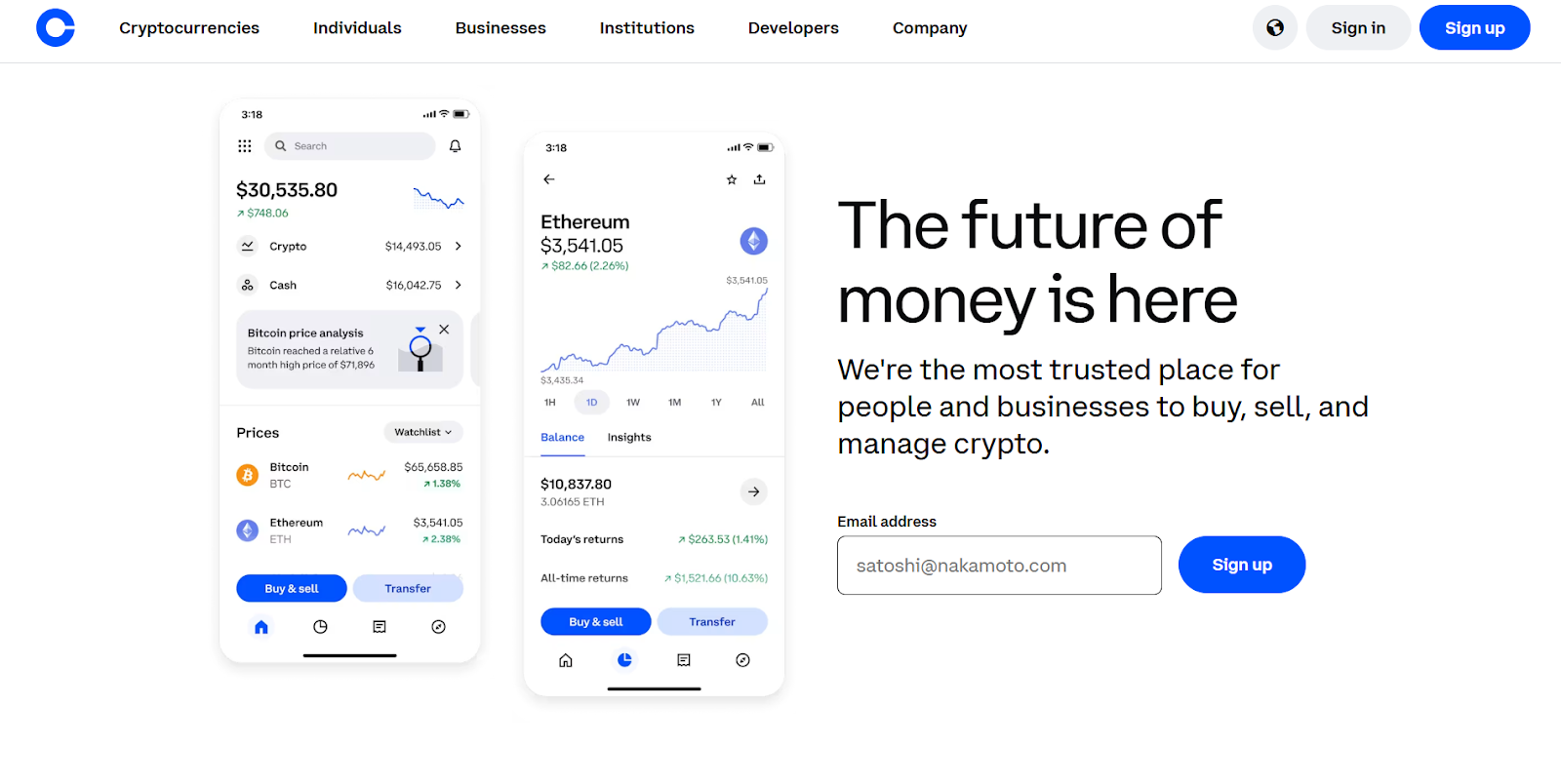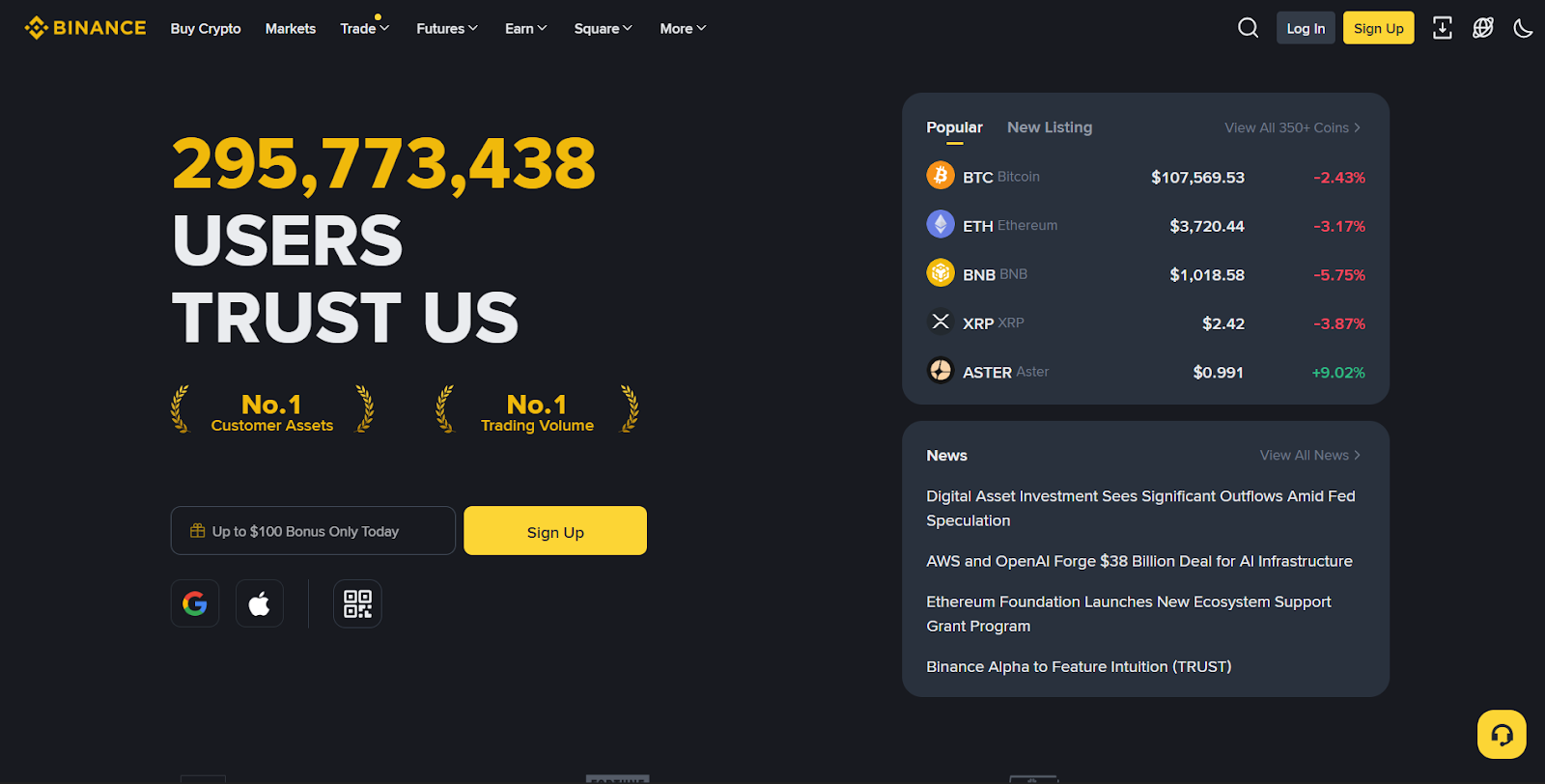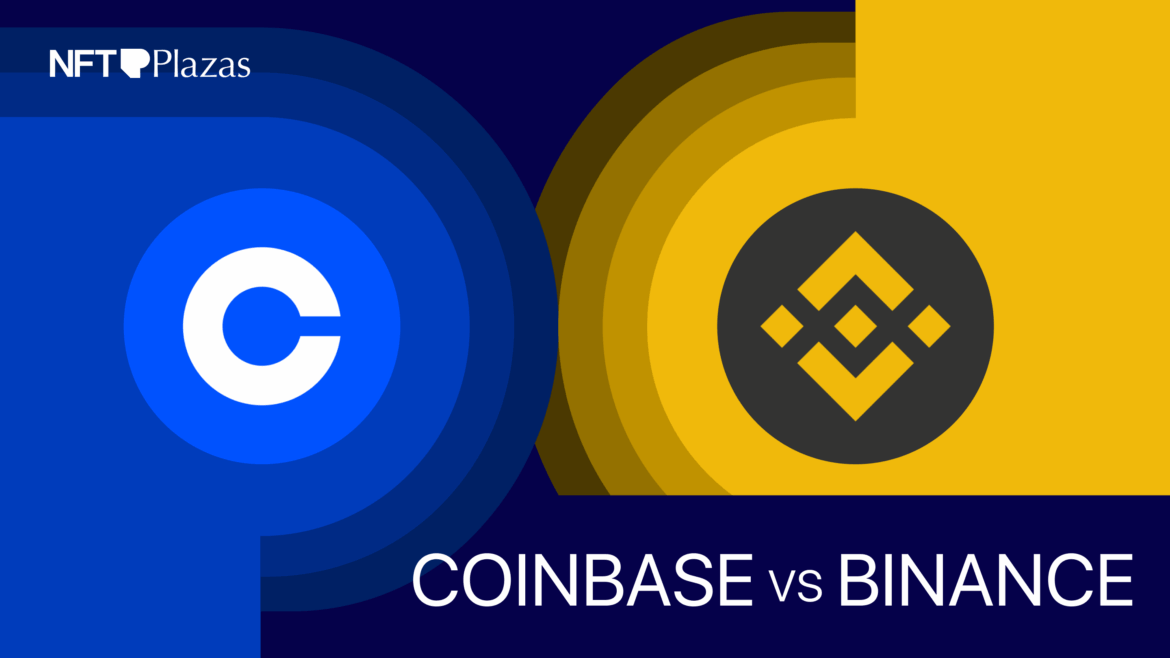Coinbase vs Binance is a clear comparison of the top crypto exchanges in 2025 to help you become an informed crypto trader. Binance had over $100 trillion in trading volume in 2024, while Coinbase teamed up with 245,000 ecosystem players. These platforms are major players in the crypto world. But which one truly delivers the edge you need?
In this guide, you’ll discover how Coinbase and Binance differ in fees, features, security, and overall user experience. We’ll break down what sets each platform apart and how they fit different trading goals. Keep reading to find out which exchange is the smarter choice for your 2025 crypto journey.
Coinbase vs Binance: A Glance Comparison
| Feature | Coinbase | Binance |
| User Base | Over 100 million users globally | Almost 300 million users globally |
| Assets Under Management | Not disclosed | More than $187 billion |
| 24-Hour Trading Volume | Not disclosed | More than $55 billion |
| Cryptocurrencies Supported | Hundreds of cryptocurrencies, including Bitcoin, Ethereum, and Dogecoin | Over 500 cryptocurrencies |
| Security | Best-in-class cold storage for crypto protection | $1 billion SAFU fund, 98% cold storage |
| Trading Fees | Zero fees for Coinbase One members; standard fees apply otherwise | 0.1% spot trading (0.075% with BNB), 0.02% futures maker fees |
| Promotions | Up to $2,000 in crypto for new users | Up to $100 bonus for new users |
| Global Reach | Available in over 100 countries | Available in 180+ countries |
| Unique Features | Coinbase One membership with zero fees and rewards | Advanced trading tools, Launchpool, and NFT marketplace |
What is Coinbase?


Coinbase is a leading cryptocurrency exchange founded in 2012, designed to make crypto trading accessible to everyone. It is fully U.S.-compliant and became the first publicly traded crypto company in 2021. Known for its user-friendly interface, Coinbase supports over 280 cryptocurrencies and offers features like buying, selling, sending, and exchanging digital assets.
The platform prioritizes security with 2FA, cold storage, and insurance for hot wallets. It also provides a dedicated Coinbase Wallet for self-custody. With its intuitive design and wide range of payment methods, Coinbase is a trusted choice for both new and experienced traders, with a referral code for new traders.
Pros & Cons of Coinbase
| Pros | Cons |
| Easy-to-use interface with simple navigation | Higher fees than competitors |
| Strong regulatory compliance and US licensing | Lacks advanced tools for experienced traders |
| Supports a wide range of payment methods, including PayPal | Slower deposit and withdrawal processes |
| Offers insurance for hot wallet storage and robust security measures | Supports fewer cryptocurrencies than Binance |
| Educational resources and the learn and Earn program for new users | Limited staking options and lower rewards |
Coinbase is best for:
- Beginners entering the crypto market
- Users seeking a simple, intuitive experience
- Investors prioritizing regulatory compliance
- Traders who need multiple payment options, like PayPal
- Individuals looking for secure storage with insurance
- Learners interested in educational resources and earning opportunities
What is Binance?


Binance is the world’s leading cryptocurrency exchange, trusted by over 180 million users globally. Established in 2017, it has become a powerhouse in the crypto space, offering unmatched liquidity, low fees starting at just 0.1%, and a massive selection of over 350 cryptocurrencies.
What sets Binance apart is its versatility. Whether you’re new to trading or highly experienced, Binance offers intuitive tools, enhanced trading options, and features like staking, futures, and an NFT marketplace. Operating in 180+ countries, it provides localized support and multi-language accessibility, making it a truly global platform.
Security is a top priority at Binance with industry-leading measures like the $1 billion SAFU insurance fund, two-factor authentication, and regular audits. Beyond trading, Binance is an entire ecosystem offering educational resources, DeFi tools, and innovative programs like Launchpad for early access to promising projects.
Pros & Cons of Binance
| Pros | Cons |
| Low trading fees beginning from 0.1% | Complex interface can overwhelm beginners |
| Supports over 350 cryptocurrencies | Regulatory challenges in some countries |
| Advanced trading options including futures, staking, and NFTs | Limited features for Binance.US users |
| High liquidity and fast transaction speeds | Fiat withdrawal options are restricted in certain regions |
| Strong security measures, including SAFU insurance fund | Customer support response times can vary |
| Global reach with operations in 180+ countries | Not available in some US states |
Binance is best for:
- Traders seeking low fees and high liquidity
- Users interested in advanced trading options like futures and staking
- Investors looking for access to 350+ cryptocurrencies
- Individuals who value strong security measures like SAFU insurance
- Global users needing multi-language support and localized features
- Those exploring NFTs and innovative crypto projects through Launchpad
Coinbase vs Binance: Trading Features
| Feature | Coinbase | Binance |
| Trading Options | Basic buy/sell, recurring purchases | Spot, margin, futures, options, P2P trading |
| Advanced Tools | Limited advanced tools | Advanced charting, multiple order types |
| Cryptocurrency Selection | 280+ cryptocurrencies | 350+ cryptocurrencies |
| Staking | Limited staking options | Extensive staking options with higher rewards |
| Fees | Higher fees, especially for small transactions | Low fees from just 0.1% |
| User Interface | Simple to navigate | Pro and Lite modes for different user levels |
Coinbase vs Binance: Platform Products and Services
| Category | Coinbase | Binance |
| Wallet | Coinbase Wallet for self-custody | Binance Web3 Wallet with advanced security |
| NFT Marketplace | Limited activity | Active and widely used |
| Educational Resources | Learn and Earn program | Binance Academy with extensive resources |
| Passive Income | Basic staking | Staking, liquidity farming, dual investment |
| Fiat Support | Multiple payment methods, including PayPal | Wide fiat support with P2P options |
| Ecosystem | Focused on trading and education | Comprehensive ecosystem including DeFi tools |
What Coinbase Offers:
- Easy-to-use interface for easy navigation
- Support for 280+ cryptocurrencies
- Recurring purchase options for dollar-cost averaging
- Coinbase Wallet for self-custody and DeFi access
- Learn and Earn program for educational rewards
- Advanced trade tools with real-time order books and charting
- Zero trading fees with a Coinbase One membership
- Secure cold storage for crypto assets
- Multiple payment methods, including PayPal
What Binance Offers:
- Advanced trading options: spot, margin, futures, and peer to peer trading
- Support for 350+ cryptocurrencies and extensive trading pairs
- Binance Web3 Wallet with enhanced security features
- Comprehensive staking and liquidity farming options
- Low trading fees from just 0.1%
- NFT marketplace for buying, selling, and staking NFTs
- Binance Academy for in-depth educational resources
- Global reach with operations in 180+ countries
- SAFU insurance fund for user asset protection
- Pro and Lite modes tailored for different user levels
Binance vs Coinbase: Fee Structures
| Fee Type | Binance | Coinbase |
| Spot Trading Fees | 0.1% for both makers and takers (0.075% with BNB discount) | Up to 0.6% for takers and 0.4% for makers (varies by volume) |
| Futures Trading Fees | 0.02% maker, 0.05% taker (discounts for higher VIP tiers) | Not available |
| Staking Fees | No fees for staking | 25% commission on staking rewards |
| Deposit Fees | Crypto deposits are free | Crypto deposits are free, while fiat deposits may include fees based on the payment method |
| Withdrawal Fees | Varies by cryptocurrency and network | Varies by cryptocurrency and network |
| Credit/Debit Card Fees | 1.8% for card purchases | 3.99% for card purchases |
| P2P Trading Fees | Free for buyers; 0.35% for sellers | Not available |
| Subscription Fees | No subscription fees | Coinbase One: $29.99/month for zero trading fees and other benefits |
Binance vs Coinbase: Coins Supported, Liquidity & Volume
| Category | Binance | Coinbase |
| Coins Supported | 350+ cryptocurrencies | 280+ cryptocurrencies |
| Trading Pairs | Extensive, including spot, margin and futures trading | Limited to spot trading pairs |
| Daily Trading Volume | $55+ billion | $1.5+ billion |
| Liquidity | High liquidity across all markets | Moderate liquidity, focused on major assets |
| New Listings | Frequent, with early access via Launchpad | Less frequent, focused on established assets |
Coinbase vs Binance: Security Comparison
Coinbase is often seen as the go-to platform for beginners, and its security measures reflect that. They keep 98% of customer funds in cold storage, which means your crypto is stored offline and away from potential hackers. The remaining 2% is insured, so even if there’s a breach, you’re covered.
On top of that, Coinbase uses 2FA to add an extra layer of protection to your account. You’ll also find biometric logins, like fingerprint or face recognition, for their mobile app. And if you’re worried about your personal information, Coinbase is fully compliant with US regulations, which means it follows strict data protection laws.
Binance, on the other hand, is built for traders who want more advanced features without compromising on security. They’ve got a $1 billion Secure Asset Fund for Users (SAFU), which acts as an emergency insurance fund in the event of a major hack. Like Coinbase, Binance also uses 2FA and stores the majority of funds in cold storage.
What sets Binance apart is its proactive approach to security. They conduct regular audits and even offer a bug bounty program, rewarding ethical hackers who find vulnerabilities. Plus, Binance has advanced risk management systems that monitor transactions for suspicious activity in real time.
Coinbase Security Measures:
- 98% of customer funds are stored in offline cold storage
- Insurance coverage for the remaining 2% of funds stored online
- Two-factor authentication (2FA) for account protection
- Biometric logins (fingerprint and face recognition) for mobile app access
- Fully compliant with US regulations for data protection
- Regular security audits to ensure platform integrity
- End-to-end encryption for sensitive data.
Binance Security Measures:
- Majority of funds are stored in offline cold storage
- $1 billion Secure Asset Fund for Users (SAFU) for emergency protection
- Two-factor authentication (2FA) for enhanced account security
- Advanced risk management systems to monitor suspicious transactions in real time
- Regular platform audits and penetration testing
- Bug bounty program to reward ethical hackers for identifying vulnerabilities
- Multi-layered encryption for data and transaction security
Coinbase vs Binance: Affiliate & Referral Programs
| Feature | Coinbase | Binance |
| Affiliate Program | Earn 50% of fees generated by your referrals for 3 months | Earn up to 50% of fees generated by your referrals (lifetime) |
| Referral Program | $10 bonus for both referrer and referee after a $100 trade | Up to 40% commission on trading fees based on referee activity |
| Payout Frequency | Monthly payouts | Real-time payouts |
| Eligibility | Open to individuals and businesses | Open to individuals, businesses, and influencers |
| Customization | Limited tracking tools for affiliates | Advanced tracking tools and custom referral links |
| Additional Perks | Occasional promotional bonuses | Tiered rewards for high-performing affiliates |
Binance vs Coinbase: Mobile App & User Experience
As for mobile apps and user experience, Binance and Coinbase cater to different audiences, each excelling in its own way. Binance’s app is designed for both beginners and advanced traders, offering two modes: Lite for simplicity and Pro for advanced features. Rated 4.8/5 on iOS and 4.5/5 on Android, the app provides a seamless experience with real-time charts, multiple order types, and advanced trading tools. Its standout features include a customizable interface, integration with Binance Academy for learning, and robust security measures like biometric login and two-step verification. New users can also sign up with a Binance referral code to access exclusive rewards. While the app’s Pro mode may feel complex for beginners, switching to Lite mode is a better starting point.
Coinbase focuses on simplicity and ease of use, making it a favorite among beginners. Its app, rated 4.7/5 on iOS and 4.4/5 on Android, offers a clean and intuitive design that simplifies buying and selling cryptocurrencies. While it lacks the advanced customization options of Binance, Coinbase compensates with features like the Learn and Earn program, which educates Coinbase users while rewarding them with crypto. Security is a priority, with features like biometric login, 2FA, and secure cold storage.
Binance vs Coinbase: Customer Support
As a trader, having reliable customer support can make all the difference, especially when dealing with time-sensitive issues. Binance stands out with its 24/7 global support, offering live chat in over 40 languages to cater to its diverse user base. For quick resolutions, it employs AI-powered instant responses, and VIP users enjoy the added benefit of a referral code for every invite. However, the lack of phone support and occasional delays during peak times can be a drawback for those needing immediate help.
Alternatively, Coinbase takes a more straightforward approach, focusing on clarity and ease of use. Its support includes email and live chat, complemented by a robust help center filled with FAQs and tutorials. While Coinbase’s options are more limited compared to Binance, its user-friendly resources and emphasis on user education make it a dependable choice for new traders. Coinbase and Binance aim to assist effectively, but Binance’s multilingual and round-the-clock support gives global traders an advantage.
Conclusion: Which is Better, Binance or Coinbase?
Choosing between Binance and Coinbase primarily relies on your trading needs and experience level. Binance is ideal for experienced investors who value advanced tools, extensive cryptocurrency options, and low fees. Its Pro mode, diverse trading features, and robust security measures make it a powerhouse for those seeking a comprehensive trading platform. However, its complexity and being a regulated financial institution in certain regions may deter beginners or those looking for a simpler experience.
Coinbase is a great choice for beginners or casual traders who prioritize ease of use and straightforward functionality. Its clean interface, educational resources, and strong regulatory compliance make it a reliable option for those new to cryptocurrency. While it lacks the advanced features and lower fees of Binance, Coinbase’s simplicity and focus on user education provide a solid foundation for building confidence in crypto trading. Both platforms excel in their respective areas, so the better choice depends on whether you value advanced features and low costs (Binance) or simplicity and accessibility (Coinbase).
FAQs
What’s the difference between Binance and Binance.US?
The key difference between Binance and Binance.US lies in their scope and features. Binance is a global platform with advanced trading tools and a wide cryptocurrency selection, while Binance.US is tailored for U.S. users with fewer features and a limited selection due to regulatory restrictions.
Is Binance a safe crypto exchange?
Yes, Binance is a safe crypto exchange. It employs robust security measures, including 2FA, cold storage for most funds, and the Secure Asset Fund for Users (SAFU) to protect assets in event of breaches.
Is Coinbase Wallet safer than Binance?
Coinbase Wallet is safer for users who prefer self-custody, as it gives full control over private keys. Binance, while secure, relies on centralized security measures, which require trust in the platform.
Which exchange has lower fees: Coinbase vs Binance?
The exchange with lower fees is Binance. Binance charges a base trading fee of 0.1%, which can be reduced using Binance Coin (BNB), while Coinbase fees range from 0.5% to 4.5%, depending on the transaction type.
Which exchange is more beginner-friendly: Coinbase or Binance?
The exchange that is more ideal for beginners is Coinbase. Coinbase offers a simple interface, easy buy/sell options, and educational resources, making it ideal for new traders. Binance, while offering a Lite mode, is better suited for users with some trading experience.
Which exchange is more secure: Coinbase vs Binance?
The exchange that is more secure depends on your preferences. Coinbase emphasizes regulatory compliance and insurance for online funds, while Binance offers advanced security features like the $1 billion SAFU fund and real-time risk monitoring. Both are highly secure in their own ways.


